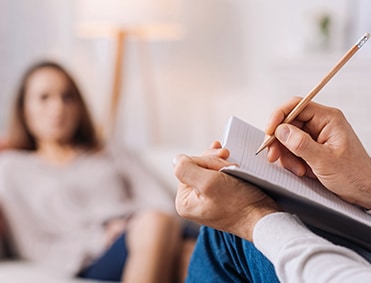Polysomnography equipment
01. EEG electrodes
Record brain activity to track
sleep stages
02. Eye electrodes
Record eye movements
03. Nasal cannula
Determines if you experience moments of apnea during sleep
04. Chin muscle electrodes
Record the activity of the chin muscle
05. Cardiogram electrodes
Record cardiac activity
06. Polysomnography central box
Analyses your movements and position, and transmits various information about your breathing
07. Chest and abdominal straps
Record respiratory movements
08. Pulse oximeter
Records your oxygen level and its variations
09. Leg muscle electrodes
Record your leg movements
Sleep recording
Visual analysis by a specialized technician
Discussion and validation during bi-monthly multidisciplinary medical meetings
Results and reports provided by your referring physician
The objectives of polysomnography
The purpose of polysomnography is to determine the quality, quantity, and organization of sleep, and to identify any disorders such as apnea or periodic limb movements during sleep.
A team of specialized and experienced technicians continuously monitors the progress of the test throughout the night. The analysis is then validated by a sleep specialist, who interprets the results in the context of the patient’s clinical condition. A summary of the results and a treatment proposal are then sent to the prescribing physician.
How your night will unfold
- Admission
- Questionnaires
- Dressing for the night
- Relaxation until 11pm
- Examinations
- End of examination and removal of equipment
Pensez à apporter :
- Toiletries
- Shampoo
- Nightwear
- Comfortable slippers and/or shoes
- Personal medications

Polysomnography procedure
This examination takes place overnight at the sleep center and sometimes during the following day (particularly for vigilance tests). Throughout the polysomnography, the patient is video-monitored to correlate the recorded data with the visual activity observed in real time by…
FAQ
How is polysomnography performed?
Nocturnal ventilatory polygraphy is a medical test that records various respiratory parameters during sleep. It is used to diagnose sleep apnea syndrome (SAHOS).
Unlike other more complex tests, ventilatory polygraphy can be performed at home. It involves recording several physiological parameters:
- Nasal airflow using a nasal cannula
- Chest and abdominal respiratory movements using belts
- Blood oxygen levels (oxygen saturation) and heart rate via a finger oximeter
Once the test is complete, the data is analyzed by a sleep specialist who can determine the presence and severity of OSAHS. The patient may be referred for appropriate treatment such as continuous positive airway pressure (CPAP).
How should I dress for polysomnography?
For a sleep study such as polysomnography or ventilatory polygraphy, it is important to wear comfortable clothing to ensure that the recording goes smoothly.
Here are a few recommendations:
- Choose loose-fitting, comfortable clothing, such as pajamas or a short-sleeved T-shirt and loose-fitting bottoms. It is advisable to avoid tight clothing that could interfere with the placement of sensors and respiratory straps.
- Avoid synthetic fabrics and opt for cotton, as some materials can promote perspiration and interfere with the proper functioning of the electrodes.
- Do not wear jewelry or makeup, as these may interfere with the sensors.
- For people with long hair, it is recommended that you tie it back loosely and avoid styling products (hairspray, gel) that may affect the adhesion of the EEG electrodes to the scalp.
- Avoid nail polish, as it can distort the pulse oximeter measurement.
By following these tips, you will ensure a comfortable examination and high-quality recordings for optimal analysis of your sleep. (I will remove this sentence.)
What’s the difference between polygraphy and polysomnography?
Polygraphy and polysomnography are two tests used to diagnose sleep disorders, but they differ in terms of accuracy and indications.
- Ventilatory polygraphy is a simpler test that can be performed at home. It mainly records respiratory parameters (nasal airflow, chest and abdominal movements, oxygen saturation, snoring). It is recommended for screening for obstructive sleep apnea-hypopnea syndrome (OSAHS) when no other sleep disorder is suspected.
- Polysomnography is much more comprehensive. Performed in a sleep center, it also records brain activity, eye and muscle movements, cardiac activity, and leg movements. It therefore allows the structure of sleep to be studied and more complex conditions such as narcolepsy, parasomnias, or restless legs syndrome to be diagnosed.
If polygraphy does not provide a clear diagnosis or if other sleep disorders are suspected, polysomnography is often necessary to refine the assessment and propose appropriate treatment.
What are the indications for polysomnography?
Polysomnography is indicated in several situations where a complex sleep disorder is suspected. This test allows for an in-depth analysis of sleep architecture and the detection of various pathologies:
- Obstructive sleep apnea-hypopnea syndrome (OSAHS): If ventilatory polygraphy performed at home has not provided a clear diagnosis, polysomnography is then prescribed for a more in-depth evaluation.
- Hypersomnia: To diagnose excessive sleepiness, polysomnography is often combined with a multiple sleep latency test (MSLT), which assesses how quickly a person falls asleep and whether they experience abnormal REM sleep.
- Parasomnias: Such as night terrors, sleepwalking, or unusual behaviors during sleep, requiring a correlation between observed events and recorded physiological data.
- Restless legs syndrome and periodic limb movements: These nocturnal motor disorders cause frequent awakenings and impaired sleep quality.
- Sleep disorders related to neurological diseases: Such as Parkinson’s disease or certain types of nocturnal epilepsy, which require in-depth sleep analysis.
- Rare nocturnal respiratory disorders: Such as hypoventilation or central respiratory disorders related to certain neurological or cardiac conditions.
Based on the results of the polysomnography, the sleep doctor will be able to make an accurate diagnosis and recommend appropriate treatment, including specific treatments or therapeutic adjustments.
